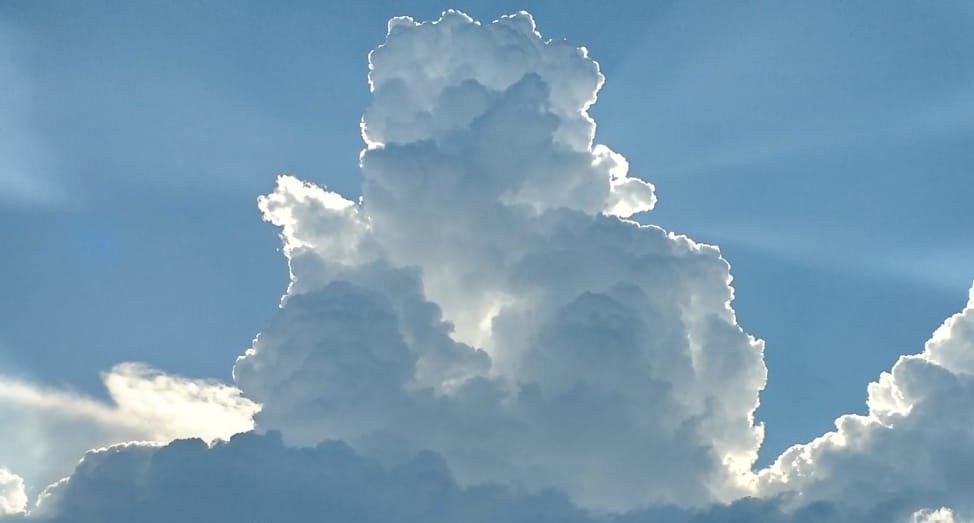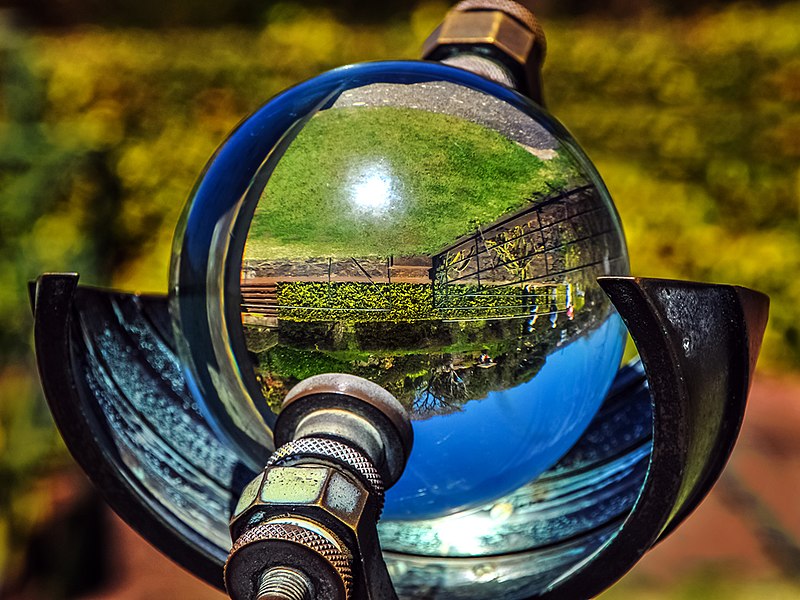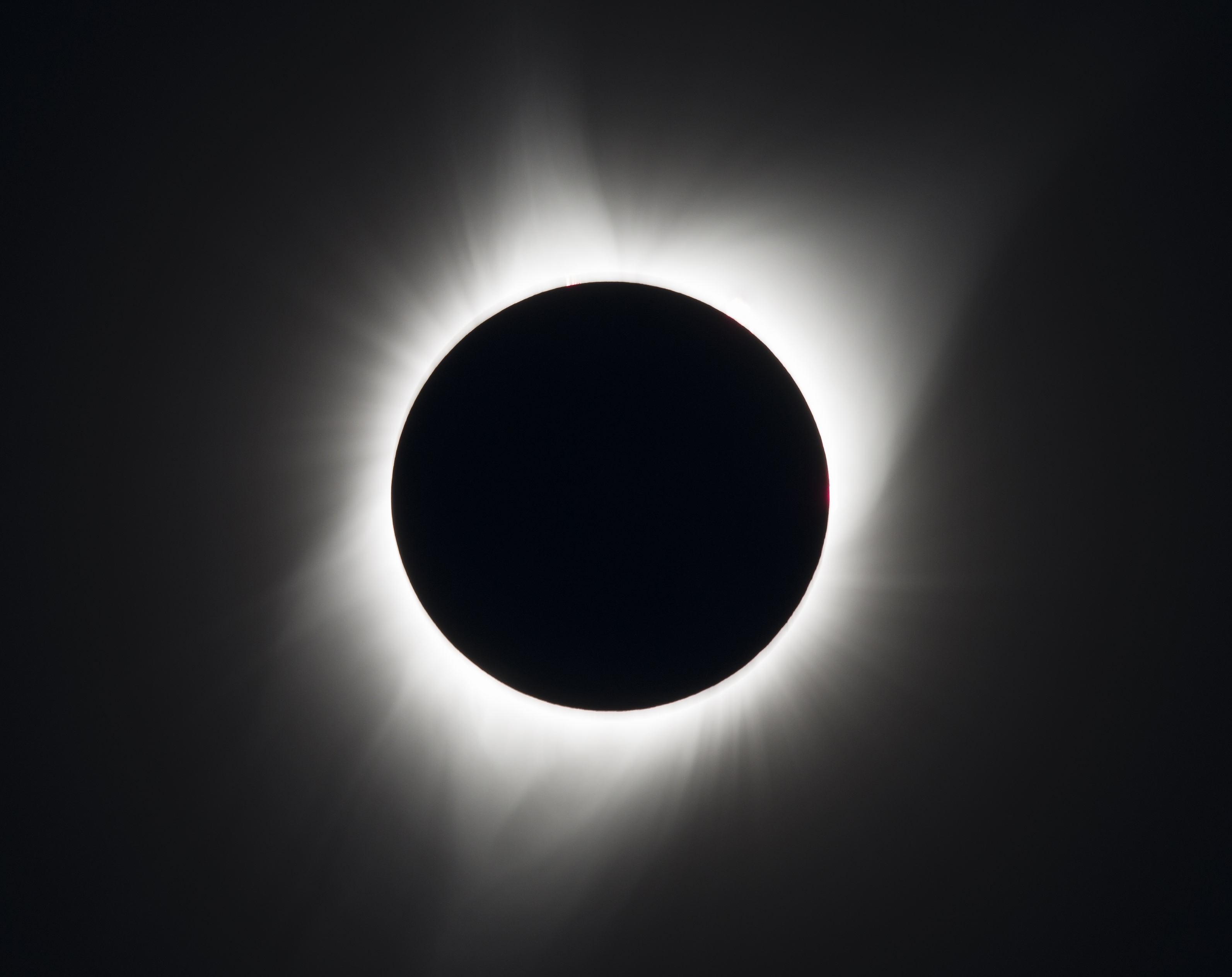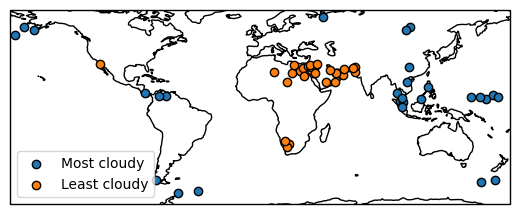Where is the cloudiest place on Earth? A quick internet search suggests the answer is Tórshavn, capital of the Faroe Islands. With less than 900 hours of sunlight per year, that is a lot of cloud. But does the amount of sunlight tell us how cloudy somewhere is?? And is Tórshavn actually the cloudiest place on Earth?
Counting clouds¶
Clouds have two key properties:
- They are wet
- They are white [1]
Generally to measure wetness (known as the cloud water content), you need to be in the cloud [2]. This is not great if we want to measure clouds around the world, as we would need lots of aeroplanes flying near constantly.
It is much easier to look for things that are white, as you can easily do this at large distances (or even from space).

Clouds: wet and (kind of) white. Clouds scatter light, so the sides in shadow appear grey
For those of us not in space, clouds don't always appear white, but often shades of grey. This is because clouds scatter light. When you view them from the same side as the sun, they reflect light (a bit like a sheet of paper) and look white. Looking at them from the opposite side to the sun, they look grey. If we want to find clouds from the surface of the Earth, we can look for things that block sunlight.
A sunshine recorder is one way to do this. The common design in most of the world is the Campbell-Stokes recorder, which uses a glass ball to focus sunlight onto a piece of card. When sunlight is strong enough, it burns the card, leaving a charred line as the sun moves through the sky. The amount of burnt paper then gives the sunshine duration.

A Campbell-Stokes sunshine recorder. The sunlight is focused at the back where it burns a sheet of card (Wikimedia Commons/Georgfotoart).
Where is the least sunny place in the world?¶
If we use sunshine (and the lack of it) as a measure of cloudiness, we can look at the WMO station averages [3] to get a list of the sunniest and least sunny places on Earth. Here are the ten sunniest and least sunny places in the WMO database.
| Least sunny | (hours) | Sunniest | (hours) | |
|---|---|---|---|---|
| 1 | Bjørnøya (Svalbard, Norway) | 595.0 | Yuma (USA) | 4015.3 |
| 2 | Macquarie Island (Australia) | 806.5 | Phoenix (USA) | 3871.6 |
| 3 | Tórshavn (Faroe Islands) | 841.0 | Aswan (Egypt) | 3862.8 |
| 4 | Ostrov Vize (Arctic Russia) | 914.0 | Las Vegas (USA) | 3825.3 |
| 5 | Rio Negro (Brazil) | 967.9 | Tuscon (USA) | 3806.0 |
So while Tórshavn is not a very sunny place, it is not even the least sunny place in Europe! However, it does appear to be the least sunny city. Bjørnøya (or Bear Island) is the least sunny place. It is the southernmost part of Svalbard chain of islands. Macquarie Island, the second least sunny, is about halfway between New Zealand and Antarctica. Neither of them has a permanent population (although both have weather observers). In contrast, the south-western USA is very sunny, with four out of the five sunniest places in the world! [4]
But what about the clouds?¶
Although sunshine recorders are a pretty simple design, relating sunshine hours to cloudiness is not as simple as it first seems. Tórshavn has very little sun, but is it also the cloudiest?
Sunshine recorders are not very clever. They just look to see how much sunlight there is, they don't tell you why there is no sunlight. Clouds are not the only thing that can block sunlight. Heavy pollution and desert dust can both block sunlight, making it look like there are more clouds.

Ignore your sunshine recorder - this is not a cloud! It is actually the Moon (and neither wet nor white). (Wikimeda Commons/NASA GSFC)
The sunshine recorders can miss clouds, calculating a cloud amount that is too small. The main problem is that sunshine recorders cannot see thin clouds. Although it is difficult to measure precisely, a cloud needs to scatter about 80% of the incoming sunlight to count as cloudy [5]. Roughly, this means that any cloud that looks white from the bottom (rather than grey), doesn't count as cloudy! [6]
To get a better measure of cloud amount, we have to get people to watch the clouds.
Compared to sunshine recorders, people have a lot of useful qualities for measuring clouds. They can see quite thin clouds, they can view the whole sky (not just the part towards the sun) and they can tell you what kind of cloud they are looking at (or if the thing blocking the sun is not a cloud). If light from the moon (or light pollution) makes clouds visible, they can also measure clouds at night! [7]
So where is the cloudiest place?¶
Lots of places measure the weather, producing data for input into the weather forecast [8]. Not all of these measure cloud, but the excellent EECRA database has collected cloud observations from stations around the globe, allowing us to find the cloudiest (and least cloudy) places on Earth for just over 5,000 locations.

The 30 cloudiest (blue) and least cloudy (orange) places in the EECRA database. See the table at the end for the locations of the top 10.
The least cloudy places are probably where you expect (see the table below). They are primarily in desert regions (Egypt, Saudi Arabia). The least cloudy place in the record is the Dakhla Oasis. In deserts, blowing sand can block out the sun, reducing the sunlight hours even without clouds. This is why the least cloudy places are not necessarily the sunniest places.
The most cloudy places are spread around the world, but the fall into two main groups. One group is near the equator, particularly in the maritime continent (Indonesia and the Philippines), including the cloudiest place in the world - Chuuk Lagoon. Although these places are cloudy, the cloud is quite thin, so they also have a lot of sun. As they are surrounded by water, it can get very humid, a great starting condition for convective clouds. Convective clouds can themselves create cirrus (thin high clouds), which is why these regions are so cloudy.
The second group of places are in the mid-latitudes - similar to the UK. The storms in these regions are responsible for the high cloud amount. This is why Tórshavn is cloudy, but other places (like Bjørnøya and Bellingshausen station in Antarctica) are even cloudier.
What about the ocean?¶
Relying on data from weather stations, we have only looked at clouds over land. A lot of the cloudiest places are islands, so it seems likely that the ocean might be quite cloudy too!
To properly measure cloudiness across the whole the world, we need to use satellite data. In the next article, we will look at how satellites see clouds, so we can find the cloudiest place on Earth!
| Cloudiest | (cloud %) | Clearest | (cloud %) | |
|---|---|---|---|---|
| 1 | Chuuk (Caroline Islands) | 92.3 | Dakhla Oasis (Egypt) | 9.7 |
| 2 | San Antonio Tachira (Venezuela) | 91.6 | Kufra (Libya) | 12.2 |
| 3 | San Fernando Apure (Venezuela) | 90.3 | Yenbo (Saudi Arabia) | 15.7 |
| 4 | Bellingshausen (Antarctica) [9] | 88.9 | Sharurah (Saudi Arabia) | 15.9 |
| 5 | Amchitka (Alaska, USA) | 88.3 | San Felipe (Mexico) | 16.5 |
| 6 | Kota Bharu (Malaysia) | 88.3 | Minya (Egypt) | 16.8 |
| 7 | Rengat (Indonesia) | 87.8 | Wejh (Saudi Arabia) | 17.1 |
| 8 | Orcadas Base (Antarctica) | 87.7 | Wadi Halfa (Sudan) | 17.2 |
| 9 | Ponape Island (Caroline Islands) | 87.7 | Jacobabad (Pakistan) | 17.7 |
| 10 | Kuantan (Malaysia) | 87.7 | Qaboos Port (Oman) | 18.5 |
Notes¶
| [1] | Clouds on Venus have a more yellow colour and Jupiter is a more reddy-brown, but we will stick to clouds on Earth for the moment |
| [2] | Some kinds of instrument, particularly those looking at microwaves, are able to measure wetness remotely. That will be a topic for another time though. |
| [3] | The 1961-1990 climatological average sunshine hours, as recorded in the WMO-Normals database |
| [4] | A big caveat here is that the data I have is incomplete. I know there is more data out there - if you have some to share to help make this more complete, I would be very grateful! |
| [5] | The WMO defines 120 Wm-2as 'sunny' |
| [6] | The design of recorders can also under-count the amount of cloud particularly where there are lots of small clouds, as the burnt areas on the card have a finite size. |
| [7] | Observers also have some disadvantages. They are not as precise as sunshine recorders and cloud amount is typically measured by observers in oktas (or eighths), where 8 oktas is overcast. They are also not as good at standing still and watching the sky, so measurements are usually only taken every three hours or so. |
| [8] | The UK Met Office database lists more than 50,000 |
| [9] | Amusingly, the picture on the wikipedia page for Bellingshausen station is cloud-free! Perhaps they don't want to advertise. |